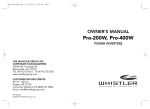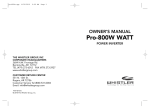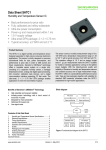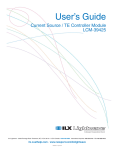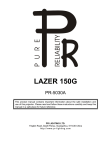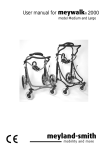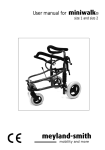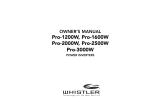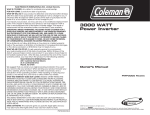Download Whistler PRO-800W WATT Owner's Owner`s manual
Transcript
OWNER’S MANUAL Pro-200W, Pro-400W POWER INVERTERS IMPORTANT INFORMATION INVERTER BASICS Important Information About Your New WHISTLER Inverter. Notes: Getting Started Power equipment and appliances which operate with motors or tubes require an initial surge of power to get them up and running. This power surge is referred to as the "starting load" or "peak load." (By comparison, electrical devices such as standard light bulbs do not require a large starting load). Once the equipment or appliance has been powered up, it settles down to a slower pace and requires far less electrical power to operate. This lower power requirement is referred to as the "continuous load." Your WHISTLER inverter is designed to operate from a 12 volt power source only. Never attempt to connect your Whistler inverter to any other power source, including any AC power source. In order to ensure that the capacity of your WHISTLER inverter is sufficient to meet the required start up load, you must first determine the power consumption of the equipment or appliance you plan to operate. This manual will provide you with directions for the safe and efficient operation of your WHISTLER inverter. Read the manual carefully before using your new WHISTLER inverter and keep the manual on file for future reference. • • • • • The length of the supplied cables is matched for the current needed by the inverter. Making this cable longer will make the inverter less efficient and may cause the cables to heat up. Do not attempt to lengthen the supplied power cables. 110 volts can be lethal. Improper use of your WHISTLER inverter may result in property damage, personal injury or loss of life. Do not connect the inverter’s output to any other power source. Not recommended for use with medical equipment. Check with the appliance manufacturer for compatibility with modified sine wave inverters. Some appliances may not work well, not at all or be damaged. For more information on compatibility issues, please visit our inverter FAQ page. Power consumption is rated either in wattage or amperes, and information regarding the required "watts" or "amps" generally is stamped or printed on most appliances and equipment. If this information is not indicated on the appliance or equipment, check the owner’s manual. Contact the appliance or equipment manufacturer to determine if the device you are using (TV’s, battery charger, computer, medical equipment, etc.) is compatible with a modified sine wave. If the power consumption is rated in amps, multiply the number of amps by 110 (AC voltage) to determine the comparable wattage rating. Induction motors, as well as some televisions, may require 2 to 6 times their wattage rating for startup. For further information on the fundamental operating principles of WHISTLER inverters and related technical data, see "Technical Operating Principles." INVERTER BASICS Don’t Push It. Although your WHISTLER inverter has the capacity to provide power output (excess current) equal to approximately two times its rated wattage capacity for a very brief period, it is designed to operate equipment and appliances with start up load wattage ratings no higher than its own maximum continuous wattage rating. For example, the Pro-400W watt model has a maximum continuous rating of 400 watts. Although this model has the capacity to briefly provide more than its continuous power (that is, excess current), it is designed to operate equipment and appliances with start up load requirements of 400 watts or less. Consequently, if the start up load rating of your equipment or appliance is slightly higher than the maximum continuous rating of the inverter, the inverter will attempt to start loads above the continuous rating for up to 10 seconds. The inverter is designed to shut down automatically in the event of a power overload. Testing appliances and equipment with start up load ratings comparable to your inverter wattage rating will not damage the inverter. However, make sure the appliance you are testing is compatible with modified sine wave inverters. See page 4 for more information. INVERTER BASICS If a piece of equipment or an appliance will not operate, first confirm that the inverter has been properly connected to the 12 volt power source (See "Making The Connection"). If all connections have been properly made, turn the inverter rocker switch ON (l), OFF (O) and ON (l) again in quick succession. If this procedure is unsuccessful, it is likely that the inverter does not have the required start up capacity to operate the equipment or appliance in question. Note: • Most heat generating appliances require start up loads in excess of 1000 watts and this inverter will not operate such appliances as coffee makers, irons, hair dryers or heaters. • The inverter’s USB Port does not support data communications. • USB power is always on and independent of the inverter’s on/off switch. OPERATION Making the Connection. This inverter is designed to connect to your 12 volt battery using the lighter socket plug or by the supplied battery cables (for appliances over 150 watts, 400 watt model only). 1. 2. 3. 4. 5. Make certain that the inverter rocker switch is in the OFF (O) position. Connect the lighter plug or hardwire cables to the power input terminals at the rear of the inverter and tighten the screws to make a secure connection. Do not use tools to tighten these screws. Steps 3 - 5 are used when any appliance requires over 150 watts. Step 6 is for appliances under 150 watts. Connect the cable from the (BLACK) Negative (-) terminal on the inverter to the Negative (-) terminal on the 12 volt power source. Make certain the connection is secure. Confirm that the cable you have just installed is properly connected. Specifically, make certain that the cable is connected to the Negative (-) terminals on both the inverter and the 12 volt power source. Connect the cable from the (RED) Positive (+) terminal on the inverter to the Positive (+) terminal on the power source. OPERATION 6. • • • • Remove the lighter and insert the adapter plug firmly into the cigarette lighter socket.* (Make certain both the socket and adapter plugs are clean.) Note: If the equipment or appliance you intend to operate requires more than 150 watts of continuous power, this inverter should be connected directly to the power source using the Hard Wire Cables (400 watt model). Failure to do so may result in serious damage to the power cord or to the cigarette socket lighter wiring. Loose connections can result in a severe decrease in voltage which may cause damage to the wires and insulation. Failure to make proper connection between the inverter and the power source will result in reverse polarity. Reverse polarity will blow the internal fuse(s) and may cause permanent damage to the inverter. Damage caused by reverse polarity is not covered under the WHISTLER warranty. Making the connection between the Positive terminals may cause a spark as a result of current flowing to the capacitors in the inverter. This is a normal occurrence. Due to the potential for sparking, however, it is extremely important that both the inverter and the 12 volt battery be well removed from any possible source of flammable fumes or gases. Failure to heed this warning could result in fire or explosion. *Some vehicle lighter sockets may only supply 10 amps or approximately 100 watts. If so, use the hardwire cables. Check vehicle’s owner’s manual for lighter socket fuse rating. OPERATION • Pro-400W watt model - If the supplied cables are too short to allow for placement of the inverter in a desired location, the inverter may be connected to the power source using a #8 wire, up to 12’. Use #4 wire for longer lengths. The steps outlined for making the connection and the related safety precautions remain unchanged. 7. Turn the inverter rocker switch to the ON (I) position. The LED Indicator Light should glow GREEN confirming that there is power running to the inverter. 8. Turn the inverter rocker switch to the OFF (O) position. (The GREEN LED Power Indicator light may “blink” briefly and/or the internal audible alarm may make a momentary “chirp”. This is normal). 9. Confirm that the equipment or appliance to be operated is turned off. Plug the equipment or appliance into one of the AC receptacles on the front panel of the the inverter. 10. Turn the inverter to the ON (I) position. Turn on the equipment or appliance. 11. Plug the USB powered device into the inverter’s USB power port. • Note: As indicated in Step 7 above, the audible alarm may make a momentary “chirp” when the inverter is turned OFF (O). The same alarm may also sound when the inverter is being connected to or disconnected from the 12 volt power source. OPERATION • • The use of an extension cord from the inverter to the appliance or equipment being operated will decrease the power being delievered to the load. For best operating results, the extension cord should be no more than 50 feet long. Check frequently to ensure that the input and output connections are secure. Loose connections may damage the inverter or the power source or may generate excessive heat. Important Information on Battery Chargers Using your inverter with battery chargers for power tools, flashlights, video cameras and laptop computers may cause damage to the inverter or the charging unit. Check with the appliance manufacturer for compatibility with modified sine wave inverters if you’re unsure. Although we advise against it, if you attempt to use a charging unit, monitor the temperature of the charging unit for approximately 10 minutes. If the charging unit becomes unusually warm, disconnect it from the inverter immediately. Don’t Blow A Fuse. This inverter is equipped with an internal spade type fuse(s). With reasonable care, it should not be necessary to replace the fuse(s) in your inverter. Most blown fuses are the result of reverse polarity or a short circuit within the appliance or equipment being operated. If the fuse(s) ADDITIONAL FEATURES OPERATION does blow, turn off and disconnect the appliance or equipment from the inverter immediately, repair the related problem and replace the fuse(s). The internal fuses are replaceable, however only electronically knowledgeable people should attempt fuse replacement. Note: • Make certain to correct the source of the overload which caused the blown fuse before turning your inverter back ON (l). The Power Source. When the engine is off, most batteries will provide an ample power supply to the inverter for one to two hours. The actual length of time is a function of several variables including the age and condition of the battery and the power demand being placed on it by the equipment being operated with the inverter. If you are using the inverter while the engine is off, we recommend you start the engine every hour and let it run for at least 10 minutes to recharge the battery. We also recommend that the device plugged into the inverter be turned off before turning over the engine. Although it is not necessary to disconnect the inverter when turning over the engine, the inverter may momentarily cease operation as the battery voltage decreases. When the inverter is not supplying power, and is turned on, it draws very low amperage from the battery (<0.70 A ). Automatic Shut Down & Related Safety Features. Each inverter has an unique LED indicator warning light system which operates in conjunction with the automatic shut down feature. These indicator lights operate as follows: GREEN LED: System ready. RED LED: System overload/automatic shut down. Your inverter will shut down automatically when any of the following problems occur: 1. The power input from the battery drops below 10 volts. 2. The power input from the battery exceeds 15.5+/-0.5 volts. 3. The continuous draw of the appliance or equipment being operated exceeds the design parameters of the inverter. The inverters are also equipped with the following additional safety features: 1. Thermal Cut Off Automatic shut down if internal temperature exceeds safe design parameters. CARE AND MAINTENANCE ADDITIONAL FEATURES 2. Low Battery Voltage Alarm/Shutdown Protection a) When the input voltage from the 12 volt power source drops below 10.5 volts, an audible tone will be heard. This is the low battery voltage alarm. b) The inverter will automatically shut down when the input voltage drops below 10 volts. This protects the battery from completely draining. In the event of automatic shut down or continuous audible alarm, turn the inverter rocker switch to the OFF (O) position until the source of the related problem has been identified and resolved. To maintain your inverter in proper working condition, note the following important safety precautions: • MOISTURE. Keep the inverter dry. Do not expose it to moisture. Do not operate the inverter if you, the inverter, the device being operated or any other surfaces that may come in contact with any power sources are wet. Water and many other liquids can conduct electricity which may lead to serious injury or death. • HEAT. For peak efficiency, the ambient air temperature should be between 50° and 80° F. Avoid placing the inverter on or near heating vents, radiators or other sources of heat. Do not place the inverter in direct sunlight. • VENTILATION. In order to disperse the heat generated while the inverter is in operation, keep it well ventilated. While in use, maintain several inches of clearance around the top and sides of the inverter. • FUMES & GASES. Avoid using the inverter near flammable materials. Do not place the inverter in areas such as battery compartments. Where fumes or gases may accumulate. Some Powerful Advice. When driving with the inverter in operation, make certain that neither the inverter nor the power cords will impede safe operation of your vehicle. Keep the unit and all cords clear of the steering wheel, gas, brake and clutch pedals and gear shift. In Review. • Never attempt to operate your WHISTLER inverter from any power source other than a 12 volt battery or group of batteries that total 12 volts. OPERATING PRINCIPLES For You Technical Types. 1. Basic Operating Principles: WHISTLER inverters work in two stages. During the first stage, the DC to DC converter increases the DC input voltage from the power source (e.g. a 12 volt battery) to 145 volts DC. In the second stage, the high voltage DC is converted to 110 volts (60 Hz AC) using advanced power MOSFET transistors in a full bridge configuration. The result is excellent overload capability and the capacity to operate difficult reactive loads. The output waveform resulting from these conversions is a "quasi-sine wave" or a "modified sine wave" as shown on below. OPERATING PRINCIPLES The majority of AC voltmeters measure RMS voltage and assume that the measured waveform will be a pure sine wave. Consequently, these meters will not read the RMS modified sine wave voltage correctly and, when measuring your WHISTLER inverter output, the meters will read about 20 to 30 volts too low. To accurately measure the output voltage of your inverter, use a true RMS reading voltmeter such as a Fluke 87, Fluke 8060A, Beckman 4410, Triplett 4200 or any multimeter identified as "True RMS." This stepped waveform is similar to the power generated by utilities and has a broad range of applications. The modified sine wave produced by the Inverter The modified sine wave produced by your Whistler inverter has a root mean square (RMS) voltage of 110 volts. A true sine wave typical of home AC outlet. OPERATION SUMMARY • • • • • This inverter is designed to be connected to the power source with the supplied cables or with #8 wire up to 12’ Use #4 wire for longer length. When utilizing the supplied cables do not attempt to modify or lengthen them. Always make certain that the power cable terminal connections Negative (-) to Negative (-) and Positive (+) to Positive (+). Check these connections frequently to ensure that they are secure. Make certain the rated power consumption of the appliance or equipment you wish to operate is compatible with the capacity of your inverter. If the rated power consumption of the equipment is in the range of the maximum specified wattage of your converter, test the inverter to ensure that it will operate properly. This Inverter is not designed to operate heat generating appliances such as coffee makers, irons, hair dryers, toasters and heaters. • Before attempting to use a battery charger see page 11. • Before attempting to use medical equipment see page 4. • Use only fuses which conform with the design specifications outlined in this manual. OPERATION SUMMARY • When operating the inverter with the engine off, start the engine every hour and let it run for at least 10 minutes to recharge the battery. • In the event of automatic shut down, turn the inverter OFF (O) immediately. Do not restart the inverter until the source of the problem has been identified and corrected. • To avoid battery drain, always disconnect the inverter when not in use. • Do not expose the inverter to moisture. • Avoid placing the inverter near sources of heat or in direct sunlight. • When in use, make certain that the inverter is properly ventilated. • Do not use the inverter near flammable materials, fumes or gases. • Always operate the inverter in accordance with the instructions in this manual. Failure to do so may result in property damage, personal injury or loss of life. TROUBLESHOOTING TROUBLESHOOTING PROBLEM: Low Battery Alarm On All The Time Please visit our Inverter FAQ page on our website (www.whistlergroup.com), for more troubleshooting information and FYI topics. Problem PROBLEM: TV Interference Solution Electrical interference from inverter. Add a Ferrite data line filter on to the TV power cord. This filter is available at electronic part stores. . PROBLEM: Low or No Output Voltage Problem Solution Using incorrect type of voltmeter to test output voltage. Use a true RMS reading meter. See "For You Technical Types" Section of this manual. Problem Input voltage below 10.5 volts. Poor or weak battery condition. Inadequate power being delivered to the inverter or excessive voltage drop. Solution Keep input voltage above 10.5 volts to maintain regulation. Replace battery. Use lower gauge wire. (400 watt model) Red LED On Problem Equipment has a high start up surge. Battery voltage below 10 volts. Equipment being operated draws too much power. Inverter is too hot (thermal shutdown mode). Solution Turn inverter power switch OFF (O) and then ON (l) again until the inverter powers your appliance. Repeat as necessary to get your appliance "started". Recharge or replace battery. Use a higher capacity inverter. Allow inverter to cool. Check for adequate ventilation. Reduce the load on the inverter to rated continuous power output. Problem TROUBLESHOOTING SPECIFICATIONS PROBLEM: TV Does Not Work Solution Pro-200W WATT INVERTER SPECIFICATIONS Maximum Continuous Power .....................200 Watts Maximum Surge Capability (Peak Power) 400 Watts* No Load Current Draw......................................<0.6 A Waveform ....................................Modified Sine Wave Operating Input Voltage Range.11– 15.5+/-0.5 Volts AC Receptacle ............ Two North American 3 Prong Fuses .................... (1) 25 Amp (Spade Type-Internal) USB..................................................5 Volt 500mA Max Approximate Dimensions 5.15" L x 3.86" W x 1.81" H Approximate Weight .......................................0.77 lbs TV does not turn on. Try rocking the ON/OFF switch of the inverter while leaving the TV ON (see page 7). Contact TV manufacturer for start-up surge and/or to find out if TV is compatible with a modified sine wave. A larger inverter may be required. WHISTLER AUDIO ACCESSORIES Pro-400W WATT INVERTER SPECIFICATIONS Maximum Continuous Power .....................400 Watts Maximum Surge Capability (Peak Power) 800 Watts* No Load Current Draw......................................<0.7 A Waveform ....................................Modified Sine Wave Operating Input Voltage Range11 – 15.5+/-0.5 Volts AC Receptacle ............ Two North American 3 Prong Fuses ......................(2) 25 Amp (Spade Type-Internal) USB..................................................5 Volt 500mA Max Approximate Dimensions 5.15" L x 3.86" W x 1.81"H Approximate Weight .........................................1.0 lbs *Under certain conditions your inverter may provide up to 2 times the continuous rating for a brief period. CAR AUDIO ACCESSORIES











